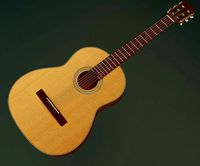Thingiverse

Stela from Late Classic Maya, at the Art Institute of Chicago by tomburtonwood
by Thingiverse
Last crawled date: 3 years ago
Late Classic Maya
Vicinity of Calakmul, Campeche or Quintana Roo, Mexico
Stela, A.D. 702
Limestone
162.6 x 68.6 x 30.5 cm (64 x 27 x 12 in.)
Wirt D. Walker Endowment, 1990.22
African Art and Indian Art of the Americas
Gallery 136
The lords of Maya city-states in southern Mexico, Guatemala, Belize, and Honduras portrayed themselves on stone monuments called stelae. Placed in plazas before the palaces and pyramids of ritual and administrative centers, these sculptures document critical information about major dynastic events between A.D. 200 and 900, including royal inaugurations, military triumphs, marriages, deaths, rituals, and key events of the agricultural cycle).
The carving style of the stela suggests that it may be from the vicinity of Calakmul, a major Classic Maya city located in Mexico’s Yucatán Peninsula, close to the border with the Petén district of Guatemala. A male figure—likely a ruler—stands in a frontal position, with his head, lower legs, and feet (now missing) turned to the viewer’s left. The subject’s gaunt face suggests that he is elderly. He holds a double-headed serpent bar across his body and is dressed in ceremonial attire associated with the Maize God, consisting of a plumed headdress, jade jewelry, a jade-netted kilt, and a spondylus seashell below the midriff. This costume symbolically connected the ruler to the earth, sky, water, and maize (corn).
Hieroglyphics carved on the left side of the monument record the date 9.13.10.0.0 in the Maya calendar, corresponding to January 26, A.D. 702, which marked the completion of a Maya 10-year period. The text on the right side documents the ritual auto-sacrificial bloodletting performed by the ruler to commemorate this significant moment in time. Although they are too highly eroded to read accurately, the hieroglyphs on the front of the stela likely name the ruler, his ancestry, and the place where he governed
http://www.artic.edu/aic/collections/artwork/75645?search_no=30&index=0
123D Catch scan by Yasmine Yafshar
Vicinity of Calakmul, Campeche or Quintana Roo, Mexico
Stela, A.D. 702
Limestone
162.6 x 68.6 x 30.5 cm (64 x 27 x 12 in.)
Wirt D. Walker Endowment, 1990.22
African Art and Indian Art of the Americas
Gallery 136
The lords of Maya city-states in southern Mexico, Guatemala, Belize, and Honduras portrayed themselves on stone monuments called stelae. Placed in plazas before the palaces and pyramids of ritual and administrative centers, these sculptures document critical information about major dynastic events between A.D. 200 and 900, including royal inaugurations, military triumphs, marriages, deaths, rituals, and key events of the agricultural cycle).
The carving style of the stela suggests that it may be from the vicinity of Calakmul, a major Classic Maya city located in Mexico’s Yucatán Peninsula, close to the border with the Petén district of Guatemala. A male figure—likely a ruler—stands in a frontal position, with his head, lower legs, and feet (now missing) turned to the viewer’s left. The subject’s gaunt face suggests that he is elderly. He holds a double-headed serpent bar across his body and is dressed in ceremonial attire associated with the Maize God, consisting of a plumed headdress, jade jewelry, a jade-netted kilt, and a spondylus seashell below the midriff. This costume symbolically connected the ruler to the earth, sky, water, and maize (corn).
Hieroglyphics carved on the left side of the monument record the date 9.13.10.0.0 in the Maya calendar, corresponding to January 26, A.D. 702, which marked the completion of a Maya 10-year period. The text on the right side documents the ritual auto-sacrificial bloodletting performed by the ruler to commemorate this significant moment in time. Although they are too highly eroded to read accurately, the hieroglyphs on the front of the stela likely name the ruler, his ancestry, and the place where he governed
http://www.artic.edu/aic/collections/artwork/75645?search_no=30&index=0
123D Catch scan by Yasmine Yafshar
Similar models
thingiverse
free

Stela, A.D. 702 by ArtInstituteChicago
...twork/75645
this thing model was captured and processed by christian oiticica. facebook.com/pages/christian-oiticica/125083464451
cg_trader
$10

Carved stelae
...carved stelae
cg trader
carved stelae carved stelae ornamental classical china architectural decoration
3dwarehouse
free

Temple 1, Nakbe
...tes the late preclassic increase in the size of buildings, as well as a shift in form and style. #guatemala #maya #nakbe #pyramid
3dwarehouse
free

Calakmul structure II
...use
model of the classic maya 8th century version of calakmul's structure 2 based on photographs and archaeological surveys.
3d_ocean
$4

Egyptian Relief
...ical karnak limestone luxor monument old pharaoh relief sculpture stone temple texture wall
egyptian relief seamless wall texture
3dwarehouse
free

CALAKMUL MAYA CAMPECHE
...calakmul maya campeche
3dwarehouse
calakmul maya campeche méxico #calakmul_maya_campeche_méxico
3dwarehouse
free

A.D. Majors Hall
...g of the building was constructed in 1960 and the west wing was added in 1965. at that time it provided housing for 210 students.
3dwarehouse
free

A.D. Majors Hall
...g of the building was constructed in 1960 and the west wing was added in 1965. at that time it provided housing for 210 students.
3dwarehouse
free

Egyptian Temple pylon with hieroglyphics
... #carving #egypt #egyptian #gate #hieroglyphics #historic #historical #holy #monument #pylon #shrine #temple #tower #towers #wall
sketchfab
$4

Jade Plaque Stone - Mayan Culture
...aya region by the 3rd century bc - jade plaque stone - mayan culture - buy royalty free 3d model by lucid dreams (@vjluciddreams)
Stela
3ddd
$1

Hansa Stela
...hansa , душ , смеситель
смеситель hansa - stela
3d_sky
$8

Hansa Stela
...hansa stela
3dsky
mixer tap hansa-stela
thingiverse
free

Hansa Stela Einsatz by sunseed
...a stela um den breiten wasserlauf zu gewährleisten. mit ist der alte einsatz leider gebrochen und ich finde kein ersatzteil mehr.
thingiverse
free

Stela, A.D. 702 by ArtInstituteChicago
...twork/75645
this thing model was captured and processed by christian oiticica. facebook.com/pages/christian-oiticica/125083464451
3d_sky
free

stand
...stand 3dsky simple model is quite original stelaa. ...
3d_sky
free

Bar counter
...bar counter 3dsky bar bar counter with stelaom ...
3d_sky
free

furniture
...furniture 3dsky furniture tables stelay. ikea coffee...
3d_sky
free

Bar counter
...bar counter 3dsky bar with cold vetrinoj and glass stelaami ...
3d_sky
free

Bar counter
...bar counter 3dsky bar bar counter with stelaom and barnym...
Tomburtonwood
thingiverse
free

camera by tomburtonwood
...camera by tomburtonwood
thingiverse
scanned with the makerbot digitizer desktop 3d scanner
thingiverse
free

Grandma by tomburtonwood
...grandma by tomburtonwood
thingiverse
scanned with the makerbot digitizer desktop 3d scanner
thingiverse
free

Mask by tomburtonwood
...mask by tomburtonwood
thingiverse
scanned with the makerbot digitizer desktop 3d scanner
thingiverse
free

bunny30 by tomburtonwood
...bunny30 by tomburtonwood
thingiverse
scanned with the makerbot digitizer desktop 3d scanner
thingiverse
free

Troll by tomburtonwood
...troll by tomburtonwood
thingiverse
scanned with the makerbot digitizer desktop 3d scanner
thingiverse
free

Ramen by tomburtonwood
...ramen by tomburtonwood
thingiverse
scanned with the makerbot digitizer desktop 3d scanner
thingiverse
free

Sponge by tomburtonwood
...sponge by tomburtonwood
thingiverse
scanned with the makerbot digitizer desktop 3d scanner
thingiverse
free

LionShark by tomburtonwood
...lionshark by tomburtonwood
thingiverse
scanned with the makerbot digitizer desktop 3d scanner
thingiverse
free

PigShark by tomburtonwood
...pigshark by tomburtonwood
thingiverse
scanned with the makerbot digitizer desktop 3d scanner
thingiverse
free

Drea by tomburtonwood
...drea by tomburtonwood
thingiverse
scanned with the makerbot digitizer desktop 3d scanner
Institute
turbosquid
$50

USSR institut
...yalty free 3d model ussr institut for download as skp and obj on turbosquid: 3d models for games, architecture, videos. (1635913)
3d_export
$9

four institutes guest house
...four institutes guest house
3dexport
four institutes of shanghai academy-chongming state guest house
3d_export
$7

auditorium of institute
...auditorium of institute
3dexport
auditorium interior on revit 2019. this model includes: .rvt, .fbx, .dxf files
turbosquid
$30

Victoria Institute of English
...a institute of english for download as 3ds, max, obj, and fbx on turbosquid: 3d models for games, architecture, videos. (1421825)
3d_export
$6

Gas claw institutions
...any questions also you can email to me. designed with solidworks 2017, render with keyshot **************************************
3d_export
$45

the marchiondi spagliardi institute by vittoriano vigano
...iondi spagliardi.<br>style: breton brute, brutalism<br>model 3d, original file rhino 6 exportation : obj, fbx and stl
cg_studio
$19

Basketball Standard, Hydra-Rib Institutional Style3d model
...a - basketball standard, hydra-rib institutional style 3d model, royalty free license available, instant download after purchase.
3d_export
$8

scifi institute couch
...) textures 4096x4096 .png / base color / metallic / normal / height / roughnes<br>: iray 2020.4.1<br>: blender 2.91.0
archive3d
free

Bed 3D Model
...el
archive3d
bed prison furniture
institutional bed 3 - 3d model for interior 3d visualization.
archive3d
free

Bed 3D Model
...el
archive3d
bed prison furniture
institutional bed 2 - 3d model for interior 3d visualization.
Late
3ddd
$1

Late
... барный
барный стул отсюдаhttp://www.danish-store.ru/collections/chairs/products/late?variant=890643065
turbosquid
$400

Late Triassic Earth
... available on turbo squid, the world's leading provider of digital 3d models for visualization, films, television, and games.
turbosquid
$400

Late Ordovician Earth
... available on turbo squid, the world's leading provider of digital 3d models for visualization, films, television, and games.
turbosquid
free

Late Model Wings
... available on turbo squid, the world's leading provider of digital 3d models for visualization, films, television, and games.
3d_ocean
$9

Clear Late Afternoon
...d a vertical cross version. spherical map has a resolution: 5000×2500 px. light probe resolution: 3000×3000 px vertical cross ...
cg_studio
$99

Tiger - Late Production3d model
...gstudio
.lwo .c4d .3ds .obj - tiger - late production 3d model, royalty free license available, instant download after purchase.
turbosquid
$99

iMac Late 2012 Station
... available on turbo squid, the world's leading provider of digital 3d models for visualization, films, television, and games.
turbosquid
$3

late hours dress 03
... available on turbo squid, the world's leading provider of digital 3d models for visualization, films, television, and games.
turbosquid
$3

late hours dress 02
... available on turbo squid, the world's leading provider of digital 3d models for visualization, films, television, and games.
turbosquid
$39

Knight's Bastard Sword, Late Medieval PBR
... available on turbo squid, the world's leading provider of digital 3d models for visualization, films, television, and games.
Chicago
3ddd
free

Диван Chicago
...диван chicago
3ddd
chicago , unital
диван chicago unital
3ddd
$1

Medica | Chicago
... кресло , массажное
офисное массажное кресло chicago фирмы medica
3d_export
$5

street chicago
...street chicago
3dexport
chicago building 120 s riverside. the 3d model has groups on buildings and materials in color.
3d_export
$5

street chicago
...street chicago
3dexport
chicago building 525 w monroe. the 3d model has groups on buildings and materials in color.
3ddd
$1

Busnelli / Chicago
...busnelli / chicago
3ddd
busnelli
диван фабрики "busnelli",модель "chicago",черная кожа.
3d_export
$15

chicago sofa
...chicago sofa
3dexport
turbosquid
$19

Posters - Chicago
...uid
royalty free 3d model posters - chicago for download as on turbosquid: 3d models for games, architecture, videos. (1467158)
3ddd
$1

Sofa Chicago
...3ddd
il loft , chicago
langth - 2400 mm ,
width - 1100 mm ,
height - 800 mm .
+ 2011 max
3ddd
$1

Диван Chicago, Busnelli
... busnelli
диван в кожаной обивке chicago, busnellihttp://www.mebel-mr.ru/content/27697.html
3d_export
$10

Chicago apartments
...chicago apartments
3dexport
Maya
design_connected
$29

Maya
...maya
designconnected
alivar maya computer generated 3d model. designed by bavuso, giuseppe.
turbosquid
$79

maya
... available on turbo squid, the world's leading provider of digital 3d models for visualization, films, television, and games.
turbosquid
$35

Maya
... available on turbo squid, the world's leading provider of digital 3d models for visualization, films, television, and games.
3ddd
$1

Maya
...maya
3ddd
барельеф , майя
это продолжение на тему майя барельеф.
3ddd
free

Brabbu Maya Armchair
...brabbu maya armchair
3ddd
brabbu , maya
brabbu maya armchair
turbosquid
$10

MAYA PYRAMID
...rbosquid
royalty free 3d model maya pyramid for download as on turbosquid: 3d models for games, architecture, videos. (1393702)
turbosquid
$2

train in maya
...squid
royalty free 3d model train in maya for download as ma on turbosquid: 3d models for games, architecture, videos. (1618372)
turbosquid
free

Phone MAYA
...rbosquid
royalty free 3d model phone maya for download as ma on turbosquid: 3d models for games, architecture, videos. (1228851)
3d_export
$5

Valkyrie Maya
...valkyrie maya
3dexport
turbosquid
$100

Sailboat Maya
... free 3d model sailboat maya for download as ma, fbx, and obj on turbosquid: 3d models for games, architecture, videos. (1536334)
Classic
3ddd
$1

classic mirror
...classic mirror
3ddd
classic mirror for classic interior design
3d_ocean
$19

Classic curtains
...classic curtains
3docean
architectural classic classical curtains decoration details drapes
classic curtains 3d max2011 fbx obj
3d_ocean
$12

classic watch
...classic watch
3docean
classic old watch
quality model classic watches
3d_export
$5

classic tools
...classic tools
3dexport
classic tools for modern and classic spaces inlaid carving
3d_export
$5

classic tools
...classic tools
3dexport
classic tools for modern and classic spaces inlaid carving
3d_export
$5

classic tools
...classic tools
3dexport
classic tools for modern and classic spaces inlaid carving
turbosquid
$50

classic
...turbosquid
royalty free 3d model classic for download as max on turbosquid: 3d models for games, architecture, videos. (1182819)
turbosquid
$20

classic
...turbosquid
royalty free 3d model classic for download as 3ds on turbosquid: 3d models for games, architecture, videos. (1346242)
3d_export
$25

classic guitar
...classic guitar
3dexport
the classical guitar is a member of the guitar family used in classical music.
3d_ocean
$19

Sofa classic
...
3docean
classic classical couch design furnishings furniture interior sofa style traditional
sofa classic max2011 fbx obj unwrap
Art
3ddd
$1

Arted
... муранское стекло
качественная модель классической люстры arted с текстурами и материалами v-ray
design_connected
$16

Arte
...arte
designconnected
willisau arte computer generated 3d model. designed by bachschmied , rainer.
3ddd
$1

Fine art art.143150st
...fine art art.143150st
3ddd
fine art lamps
автор модели: aeroslon
3ddd
$1

Arte Antiqua Comodino Art 2709
... прикроватная , тумба
arte antiqua comodino art 2709 570*320*700
3ddd
$1

Arte Lamp
...y a4034lt-1br
два настольных светильника бренда arte lamp: arte cosy a4034lt-1br и arte cosy a4318lt-1bz.
приятного пользования.
3ddd
free

Arte Maestro
...arte maestro
3ddd
arte maestro
люстра arte maestro
3ddd
free

Arte Maestro
...arte maestro
3ddd
arte maestro
бра arte maestro
3ddd
$1

Arte Veneziana
...arte veneziana
3ddd
arte veneziana
зеркало зеркало arte veneziana
3ddd
$1

Arte Lamp
...arte lamp
3ddd
arte lamp
arte spiral a9051lm-12br
3ddd
$1

Fine Art
...fine art
3ddd
fine art lamps
торшер fine art
